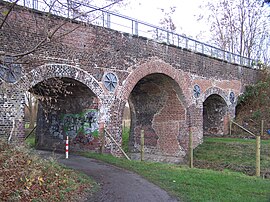United Schürbank & Charlottenburg colliery
| United Schürbank & Charlottenburg colliery | |||
|---|---|---|---|
| General information about the mine | |||
|
Feldchenbahnbrücke over the Emscher, the only remaining structure of the colliery |
|||
| Information about the mining company | |||
| Employees | about 500 | ||
| Start of operation | 1811 | ||
| End of operation | 1925 | ||
| Funded raw materials | |||
| Degradation of | Hard coal | ||
| Geographical location | |||
| Coordinates | 51 ° 30 '12 " N , 7 ° 33' 28" E | ||
|
|||
| Location | Aplerbeck | ||
| local community | Dortmund | ||
| Independent city ( NUTS3 ) | Dortmund | ||
| country | State of North Rhine-Westphalia | ||
| Country | Germany | ||
| District | Ruhr area | ||
The colliery Schürbank & Charlottenburg was a former coal mine in Dortmund district Aplerbeck .
history
Beginnings
The colliery was created in 1811 by merging the Schürbank and Charlottenburg collieries . The construction of a horse-drawn tram in 1864, which crossed the Emscher with the help of the Feldchenbahnbrücke , connected the mine to the Dortmund – Soest line of the Bergisch-Märkische Eisenbahn, which opened in 1855, and thus opened up new sales markets. The mine found this primarily in the Hermannshütte in Hörde, founded in 1841, and in the Aplerbecker Hütte, which opened in 1857 .
In 1872, the United Schürbank & Charlottenburg colliery had a capacity of 1,624,632 quintals of coal with 460 employees .
Strikes
At the mines in the Aplerbeck district, the miners' strike lasted from May 11th to May 21st from 1889 and, according to the report of the bailiff Gutjahr, took place "with exemplary discipline and without disturbing public peace and order". In contrast to the neighboring Schleswig colliery in Dortmund-Brackel , the non-working day ended bloodlessly.
Another strike in January 1893 lasted only a few days and, according to official records, was "only staged by the younger, 16-20 year old miners" and the fathers of the family "refused to go about this". The strike was apparently caused by the miners' strike in the Saar area since 1892.
Accidents
In May 1869, one of four steam boilers on the winder exploded, killing one and injuring three.
On December 27, 1871, a firedamp explosion killed 13 miners, who left ten widows and 34 minor orphans. The cause of the explosion was apparently the management's disregard for the weather concentrations and the issue of poorly maintained lights .
On January 28, 1920, a flood occurred that locked 86 miners in the mine for ten hours, but no one was killed.
Shutdown
Due to further difficulties with the dewatering , the mine had to be shut down in 1925.
Today only the Feldchenbahnbrücke, which is now used as a pedestrian bridge, reminds of the existence of the colliery.
literature
- Wilhelm Hermann, Gertrude Hermann: The old mines on the Ruhr. Verlag Langewiesche Nachhaben, Königstein im Taunus, 6th, expanded and updated edition. 2008, ISBN 978-3-7845-6994-9 , p. 174.
Internet
- www.aplerbeck-damals.de
Individual evidence
- ^ The miners' strike in May 1889 (PDF) aplerbeck-damals.de. May 15, 2014. Retrieved September 14, 2019.
- ↑ The miners' strike in Januar1893 aplerbeck-damals.de (PDF). May 15, 2014. Retrieved September 14, 2019.
- ↑ Accidents at work at the ver. Schürbank & Charlottenburg colliery (1869-1920) (PDF) aplerbeck-damals.de. July 28, 2012. Retrieved September 14, 2019.

